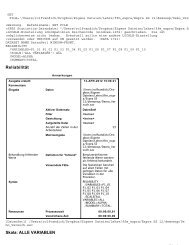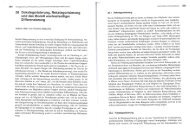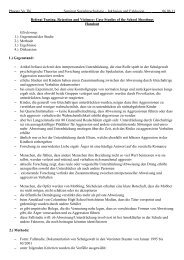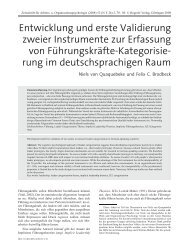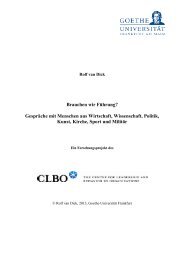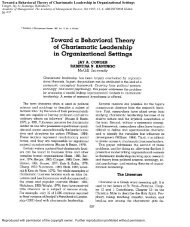Social Identity Theory and Self-categorization Theory: A Historical ...
Social Identity Theory and Self-categorization Theory: A Historical ...
Social Identity Theory and Self-categorization Theory: A Historical ...
Create successful ePaper yourself
Turn your PDF publications into a flip-book with our unique Google optimized e-Paper software.
208 <strong>Social</strong> <strong>Identity</strong> <strong>Theory</strong> <strong>and</strong> <strong>Self</strong>-<strong>categorization</strong> <strong>Theory</strong><br />
theories, many people now refer to the ‘social identity perspective’ or the<br />
‘social identity approach’ to refer to both SIT <strong>and</strong> SCT, but with an<br />
acknowledgement that the two traditions have different foci <strong>and</strong> emphases.<br />
In SCT, Turner <strong>and</strong> colleagues returned to the <strong>categorization</strong> process<br />
that was considered fundamental to SIT. But rather than seeing interpersonal<br />
<strong>and</strong> intergroup dynamics as opposite ends of a bipolar spectrum, the<br />
proponents of SCT characterized identity as operating at different levels of<br />
inclusiveness. Turner <strong>and</strong> colleagues nominate three levels of self-<strong>categorization</strong><br />
that are important to the self-concept: the superordinate category of the<br />
self as human being (or human identity), the intermediate level of the self<br />
as a member of a social ingroup as defined against other groups of humans<br />
(social identity), <strong>and</strong> the subordinate level of personal self-<strong>categorization</strong>s<br />
based on interpersonal comparisons (personal identity). It was acknowledged<br />
that it is possible to uncover finer gradations of the intermediate level of<br />
abstraction, a possibility that has since been explored in the work on<br />
subgroup identities (Hornsey & Hogg, 2000). It is also assumed that there<br />
is a ‘functional antagonism’ between the levels of self-definition, such that<br />
as one level becomes more salient the other levels become less so.<br />
Given the large constellation of social identities to which people have<br />
access, what determines which particular identity will become the basis<br />
for <strong>categorization</strong> in any one context? According to SCT, <strong>categorization</strong><br />
(including self-<strong>categorization</strong>) occurs as a function of both accessibility<br />
<strong>and</strong> fit (Oakes, 1987; Oakes, Turner, & Haslam, 1991). Fit refers to the<br />
extent to which the social categories are perceived to reflect social reality;<br />
that is, the extent to which they are seen to be diagnostic of real-world<br />
differences. Individuals may perceive a high level of fit if the category<br />
distinction maximizes perceived intercategory differences <strong>and</strong> minimizes<br />
intracategory differences (comparative fit). This principle – referred to as the<br />
meta-contrast ratio – clearly owes an intellectual debt to classic work on<br />
<strong>categorization</strong>, in the sense that it argues that categories form in such a<br />
way that maximizes intraclass similarities <strong>and</strong> interclass differences. But<br />
SCT extends this argument by making it explicit that this process is<br />
dynamic, varying according to the context, <strong>and</strong> always defined relative to<br />
the perceiver. For example, a category distinction is also more likely to<br />
have high fit if social behavior <strong>and</strong> group membership are in line with<br />
stereotypical expectations (normative fit). Furthermore, categories are more<br />
or less likely to be a basis for self-definition if they are more or less<br />
accessible in the moment. Categories may be fleetingly accessible if they<br />
are primed in the situation, or they may be chronically accessible if<br />
frequently activated or if people are motivated to use them.<br />
One of the cornerstones of SCT is the notion of depersonalization.<br />
Proponents of SCT argue that people cognitively represent their social<br />
groups in terms of prototypes. When a category becomes salient, people<br />
come to see themselves <strong>and</strong> other category members less as individuals<br />
<strong>and</strong> more as interchangeable exemplars of the group prototype. The<br />
© 2008 The Author <strong>Social</strong> <strong>and</strong> Personality Psychology Compass 2/1 (2008): 204–222, 10.1111/j.1751-9004.2007.00066.x<br />
Journal Compilation © 2008 Blackwell Publishing Ltd




